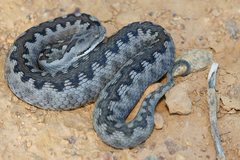Iberian grass snake
Natrix astreptophora
Natrix astreptophora, commonly known as the Iberian Grass Snake, is a non-venomous snake species native to the Iberian Peninsula. It is often found in the Comunidad Valenciana, thriving in a variety of habitats including wetlands, rivers, and streams, as well as agricultural and forested areas.
Characteristics:
- Size: Typically ranges from 70 to 120 cm in length, although some individuals may grow larger.
- Coloration: This species usually has a greenish or olive coloration, with a series of dark spots along its back and sides. Younger individuals often have a more pronounced pattern.
- Head: The snake's head is slightly wider than its body, with round pupils and a distinct separation between the head and neck.
Behavior:
- Diet: Diet primarily consists of amphibians, particularly frogs and toads, but they may also eat small fish and invertebrates.
- Reproduction: Breeding occurs in spring, with females laying clutches of 10 to 30 eggs in July, which hatch in the late summer or early autumn.
- Defense: When threatened, Natrix astreptophora may release a foul-smelling secretion from its anal glands or play dead to deter predators.
Conservation Status: While not currently considered to be at risk, the Iberian Grass Snake, like many reptile species, faces threats from habitat destruction, pollution, and climate change. Conservation efforts in the Comunidad Valenciana focus on preserving its natural habitats and raising awareness about the importance of reptiles in the ecosystem.






